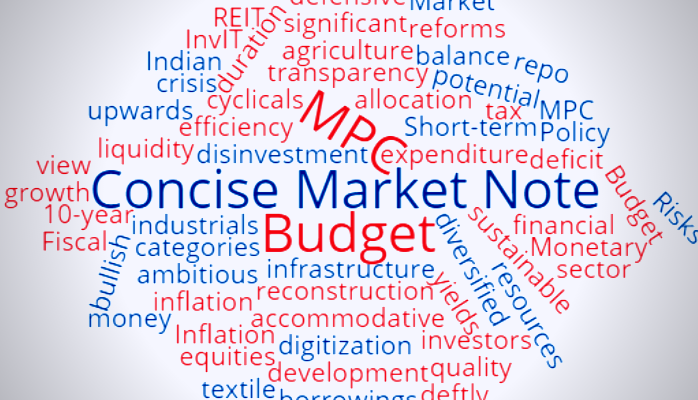The Budget presented on Feb 1, 2020 is highly growth oriented. Fiscal deficit will be at a high of 9.3% and with a slow glide down path towards 4.5% in the year 2025. Also the extra money is for capital rather than revenue expenditure and is very well targeted at infrastructure, agriculture and health care. There is more transparency with off balance sheet items moved to the balance sheet and being counted as part of the deficit.
Taxation has been left largely undisturbed with no levy of Covid cess or increase in capital gains tax – the financial market was relieved to see a stable tax regime. Instead, there is focus on the disinvestment route to raise resources. A very substantial amount is proposed to be raised through a combination of sale of PSUs, issue of REIT and InvIT and a company is being set up to monitor and provide impetus to the disinvestment programme. Importantly, with an ambitious disinvestment agenda, the government will do its best to avoid any action with a potential to disturb the financial markets.
The Budget is building up further on the already functioning production linked scheme which is being extended to 13 sectors. Additionally, there is a proposal to create 7 textile parks over 3 years.
There are lots of financial sector reforms including the setting up of a development finance institution, an asset reconstruction company for addressing NPAs, raising foreign investment limit in the insurance sector and privatization of two public sector banks.
In my article of January 5, 2021, I had written that Covid crisis in a paradoxical way has presented India with an opportunity for a sustainable economic growth in the future. Largely, the government through various measures has taken steps to realize that potential.
However, there are a few risks. High fiscal deficit will lead to large government borrowings and can lead to bond yields going up. It can also be inflationary, thus limiting the ability of RBI to remain accommodative. Execution will be the key, for example, the government along with RBI will have to manage the finances deftly. Also, the infrastructure projects will have to be implemented with time and price efficiency.
Therefore, review of today’s Monetary Policy Committee decisions is very important. RBI announced that repo rate will not be changed from its present level of 4%. It will also maintain its accommodative stance towards rates as well as liquidity management. Cash reserve ratio will be nudged upwards gradually. RBI is estimating inflation to be around 5% and growth to be 10.5% during the next year.
One very significant announcement is that the retail investors can open a direct account with RBI and buy government securities. It can also be perceived as yet another significant digital initiative from the government in addition to paperless budget and the first digital census to be carried out soon.
10-year bond yields went up 8 basis points to 6.15% but are now gradually settling down and presently at 6.1%. Generally, the market consensus is that RBI should be able to keep the bond yields in a range of 6 – 6.25% during the next few months.
Overall, post budget & MPC, my bullish view on Indian equities remains intact. The market also responded very nicely to the budget and has gone up 8% during the last 3 days. It will mainly be a broad based rally with cyclicals including financial, infrastructure and industrials doing particularly well. IT sector because of global digitization trend will do well and can be perceived as both defensive and attacking and therefore should have a reasonable allocation in the portfolio. The long term money should continue to be in equities expressed mainly through high quality diversified schemes with a good track record. These could be a combination of high quality large & mid cap schemes combined with focused and flexi cap categories.
Risks as outlined earlier are the bond yields and inflation moving up because of large fiscal deficit. Inflation indicators will have to be monitored closely. Short-term money therefore should only be in the short term or ultra – short term debt funds with low duration risk.






